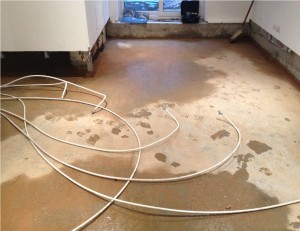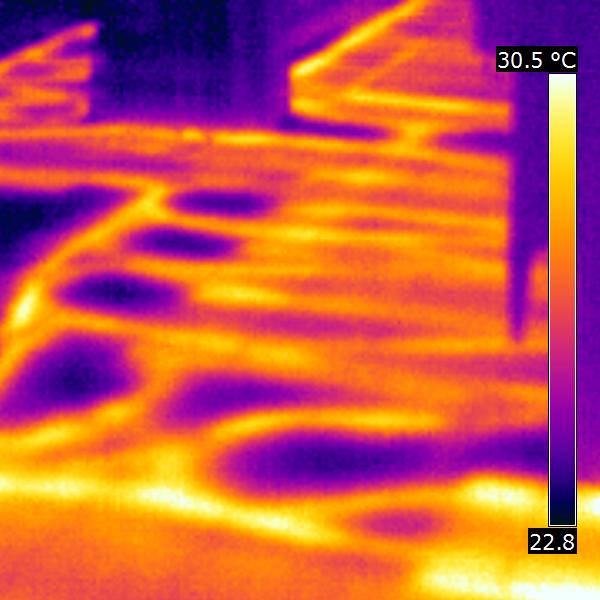Poorly Installed Underfloor Heating System – In cold February, it is common for us to turn up our heating to higher temperatures than we would at any other time of year.
If we are lucky enough to have underfloor heating, it can be a blessing; no one wants to stand on a cold kitchen floor whilst they make their breakfast. However, no one expects their underfloor heating pipes to melt the lino on their kitchen floor either!
We were called out to a property in North East London, E17, to conduct a thermal imaging survey on a kitchen floor as our clients suspected it was leaking. Our clients had not monitored their pressure meter for their central heating system, so we had no information about whether the central heating system was losing pressure or not. Over the course of three days, we asked the clients to keep a picture diary of their pressure clock on their boiler so that we could monitor to see if the pressure dropped; the pressure was not dropping.
We were called out to a property in North East London, E17, to conduct at thermal imaging survey on a kitchen floor as our clients suspected it was leaking. Our clients had not monitored their pressure meter for their central heating system, so we had no information about whether the central heating system was losing pressure or not. Over the course of three days, we asked the clients to keep a picture diary of their pressure clock on their boiler so that we could monitor to see if the pressure dropped; the pressure was not dropping.
Underfloor Heating Leak?
No thermostat or temperature regulator had been plumbed into the the underfloor heating system. The temperature of a wet underfloor heating system should be regulated separately to the rest of a central heating system to ensure that the underfloor heating never exceeds 55°C maximum recommended temperature by 26°C. As a result, the lino had begun to melt and blister in places, and the pathology of the underfloor heating cold be observed in the blister patterns. Evidence of water damage to the walls behind the kitchen units and Thermal imaging investigation uncovered a leak in the hot water supply to the kitchen sink below the floor screed. We therefore removed all the kitchen units that rested on the floor, and pulled up the ruined lino.
The following discoveries were made:
The underfloor heating pipes have been poorly installed and not to the correct specification. Not only does this mean that the floor will have numerous cold spots where the heating doesn’t warm it up, but they are too close to the surface, and heat up to temperatures that shouldn’t be reach, and therefore it has a dramatically adverse affect on the floor covering.
Our job was not to sort out the mess which was their underfloor heating, but to diagnose the reason behind the water damage in the kitchen behind the units, to fix the pipe below the floor level, and carry out all remedial works.
Thermal Imaging to Find Leaks and Other Problems
Why did the hot water pipe leak in the first place? Who knows.It could have had something to with the over expansion of the concrete and the pressure on the joint beneath the screed, it could be that the lime in the concrete had eaten away at the unlagged, oxidized copper pipe, or it could simply be something to do with the extremely cold weather and it being an exceptionally old system. The point is, non destructive testing such as thermal imaging can tell the client a lot more about their water damage or domestic heating problems than intrusive methods, and what may look like water damage at first glance, isn’t always a direct result of water. In this instance, the investigation of the consequences of an unregulated (uncontrolled) underfloor heating system, led to the discovery of a burst hot water pipe. Once again, thermal imaging has proven to be the the diagnostic way forwards.


Speak Your Mind